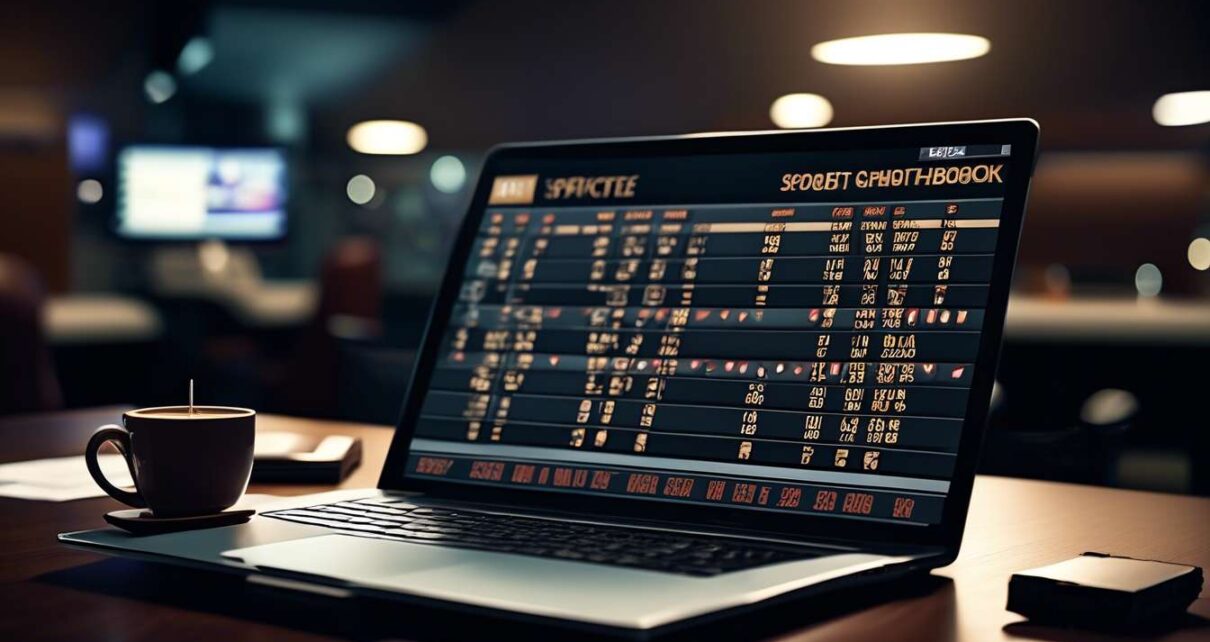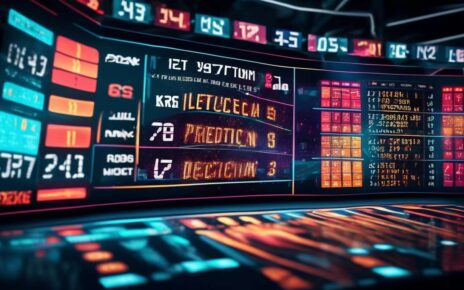When we first ventured into the world of sports betting, the myriad of numbers and symbols presented a daunting challenge. It seemed like an impenetrable code reserved for seasoned experts. However, as we delved deeper, we discovered that understanding betting odds isn’t just for the pros; it’s a skill that anyone can master with the right guidance.
Our journey taught us that these odds are not merely numbers but keys to making informed decisions. By learning to interpret them, we gained insights into potential outcomes and value bets, enhancing our overall betting experience.
In this guide, we aim to demystify the complexities of betting odds, breaking them down into easy-to-understand concepts. Whether we’re dealing with:
- Fractional odds
- Decimal odds
- Moneyline odds
We’ll provide you with the tools to read and analyze them like a pro, empowering us all to make smarter, more confident bets.
Understanding Different Types of Odds
Understanding Sports Betting Odds
Odds are more than just a set of numbers; they represent the probability of an event occurring and help us assess the potential value of a bet. By understanding different types of odds, we enhance our ability to make informed decisions and feel more at home among fellow enthusiasts.
Types of Odds
We typically encounter three main types of odds:
-
Decimal Odds
- Commonly used in Europe.
- Offer a straightforward approach by showing potential returns per unit staked.
-
Moneyline Odds
- Popular in the US.
- Indicate how much profit we can make on a specific wager.
-
Fractional Odds
- Often used in the UK.
- Express the profit relative to the stake.
The Role of Odds in Betting
Odds not only express probability but also connect us to a vibrant community of bettors. By grasping these odds, we’re not just placing bets; we’re joining a collective journey of excitement and strategy. Understanding these odds allows us to make better-informed betting decisions, enhancing the overall experience.
Deciphering Fractional Odds
Let’s dive into the world of fractional odds, where understanding the relationship between profit and stake becomes essential for making informed bets.
As a community of betting enthusiasts, we often encounter fractional odds expressed as something like 5/1 or 3/2.
- In these examples:
- The first number represents the potential profit.
- The second number is our stake.
Example Calculation:
If we bet $10 on 5/1 odds, we stand to gain $50 in profit, plus our original stake.
To feel confident and part of the betting world, we must grasp the probability behind these odds. Fractional odds can be converted into probability by dividing the second number by the sum of both numbers.
- For 5/1, the implied probability is calculated as follows:
- Probability = 1 / (5+1)
- Which equals roughly 16.67%.
Recognizing these probabilities helps us identify value bets—those where the implied probability is lower than the actual chance of an event happening.
By mastering fractional odds, we enhance our betting acumen and strengthen our community bond.
Mastering Decimal Odds Calculation
Decimal Odds Overview
Decimal odds offer a straightforward way to calculate potential returns on bets. They show the total return from a one-unit stake, including the original bet.
For example:
- Odds of 2.50 mean a $10 bet returns $25 ($10 x 2.50).
Calculating Implied Probability
Understanding probability is crucial for assessing the value of bets. The implied probability of a bet can be calculated by dividing 1 by the decimal odds.
For example:
- Odds of 2.50 have an implied probability of 1 / 2.50 = 0.40, or 40%.
Benefits of Understanding Decimal Odds
- Simplification: Decimal odds simplify the betting process by clearly showing potential returns.
- Value Assessment: They help assess whether a bet holds value by comparing the odds to the actual likelihood of an outcome.
- Community Engagement: Mastering decimal odds enhances your ability to make informed decisions, increasing your connection with fellow bettors and fostering a sense of belonging in the community.
Unveiling the Secrets of Moneyline Odds
Moneyline Odds Overview
Moneyline odds are a straightforward yet powerful tool in betting strategies. They provide a clear indication of the potential value in our bets.
Understanding Moneyline Odds:
- Positive Odds: Indicate the profit on a $100 wager. For example, +150 means a $100 bet could yield a $150 profit.
- Negative Odds: Show the amount needed to bet to win $100. For instance, -150 means you need to bet $150 to win $100.
Key Insight: Recognizing when odds offer good value is crucial. This means identifying situations where the potential reward outweighs the risk involved.
Strategic Approach
Informed decision-making is the cornerstone of successful betting. By analyzing moneyline odds, we can enhance our strategies:
- Compare Odds: Evaluate the odds set by bookmakers against your own assessment of a team’s probability of winning.
- Identify Opportunities: Look for instances where the bookmaker might have underestimated the likelihood of an outcome.
This method not only strengthens our strategies but also fosters a deeper connection with fellow bettors, as we all aim to maximize returns from each wager.
Converting Odds to Implied Probabilities
Let’s dive into the process of converting betting odds into implied probabilities to better assess potential wagers. Understanding the odds and converting them into probabilities can help evaluate the chances of an outcome occurring. This understanding strengthens our sense of community and confidence when discussing bets.
For Decimal Odds:
The formula is straightforward:
[\text{Probability} = \frac{1}{\text{Odds}}]
- Example: With odds of 2.50, the implied probability is (\frac{1}{2.50} = 0.40) or 40%.
This gives us a common ground to discuss potential wagers with fellow enthusiasts.
For American Odds:
A slightly different approach is required depending on whether the odds are positive or negative.
-
Positive Odds:
- Formula: (\text{Probability} = \frac{100}{\text{Odds} + 100})
-
Negative Odds:
- Formula: (\text{Probability} = \frac{\text{Odds}}{\text{Odds} – 100})
By mastering these conversions, we gain valuable insights into whether a bet offers value.
Understanding implied probabilities helps us make informed choices, aligning us with those who approach betting with a shared knowledge and strategy.
Identifying Value in Betting Odds
When we evaluate betting odds, we must determine if the potential return outweighs the risk involved. To do this, we need to identify value in the odds presented. Value betting is all about finding situations where the probability of an outcome happening is greater than what the odds suggest. It’s like finding that hidden gem that connects us as savvy bettors.
Let’s break it down together:
-
Calculate the Implied Probability:
- If the odds are 3.0, the implied probability is 33.33%.
-
Assess Your Own Estimation:
- Determine your estimation of the actual probability.
- If you believe the probability is higher, say 40%, you’ve found value.
This shared understanding helps us make informed decisions and fosters a sense of belonging in a community that values strategic thinking.
By consistently identifying value, we’re not just betting blindly; we’re making educated choices. This approach strengthens our connection as a group of informed bettors, united by our pursuit of value.
Recognizing Odds Movement Signals
Monitoring Shifts in Betting Odds
We need to closely monitor any shifts in betting odds as they can indicate underlying changes in market sentiment or new information affecting the outcome. When odds move, it suggests a shift in probability, which can be a clue that something significant is happening.
By understanding these movements, we can feel more connected to the pulse of the betting world, giving us a sense of belonging in this dynamic community.
Factors Influencing Odds Movement
Odds movement might reflect:
- Changes in team line-ups
- Injuries
- Weather conditions
As we watch these signals, we should ask ourselves whether the odds now offer better value or if the probability of an outcome has been misjudged by others.
Making Informed Decisions
In this shared journey, recognizing these shifts helps us:
- Make more informed decisions
- Enhance our ability to spot value bets
Community Engagement
Let’s stay vigilant, share insights, and analyze together. Embrace the thrill of the chase as we navigate the complex yet rewarding landscape of betting odds.
Putting Odds Reading into Practice
Applying Skills to Real-World Scenarios
Let’s dive into applying our newfound skills to real-world scenarios, where we can test our understanding and make strategic bets. We’ve learned how to read odds, and now it’s time to put that into practice, turning numbers into insights and insights into winning strategies.
Evaluating Odds and Identifying Value Bets
When we assess odds, we’re essentially evaluating the probability of an outcome and determining if there’s value in the bet.
Consider a football match where:
- Team A has odds of 2.50.
By converting these odds, we see they imply a 40% probability of winning. If our analysis suggests Team A has a 50% chance, we’ve identified a value bet—a scenario where the odds are in our favor.
Building a Community of Bettors
By using this knowledge, we can join communities of like-minded bettors to:
- Share insights
- Refine our approach
By embracing a strategic mindset, we’re not just placing bets; we’re part of a community striving for success, united by our shared understanding of odds and probability.
What factors influence the setting of betting odds by bookmakers?
When bookmakers set betting odds, they consider various factors that impact the likelihood of different outcomes.
Key Factors:
-
Team Performance: Current form and statistics of the team can significantly influence odds.
-
Player Injuries: The absence or presence of key players due to injuries can alter the expected performance of a team.
-
Historical Data: Past matchups and outcomes provide a basis for predicting future results.
-
Public Sentiment: Public opinion and betting patterns can sway the odds as bookmakers adjust to balance their books.
By analyzing these elements, bookmakers aim to create odds that accurately reflect the probabilities of different results.
This process allows them to offer fair and competitive odds to attract bettors while also balancing their own risks.
How do external events or news impact the fluctuation of betting odds?
External events or news can significantly impact the fluctuation of betting odds.
When unexpected occurrences arise, such as:
- Injuries to key players
- Changes in weather conditions
Bookmakers quickly adjust the odds to reflect the new information.
This rapid response ensures that:
- The odds accurately represent the current situation.
- The bookmaker’s risk exposure is managed effectively.
As a result, staying informed about external events can provide valuable insights for making informed betting decisions.
Are there any common psychological biases that affect bettors when interpreting odds?
When interpreting odds, we often fall prey to common psychological biases. These biases can influence our decision-making process and lead to errors in judgment.
It’s crucial to be aware of these tendencies to make more informed and rational betting choices. Some common biases include:
- Overconfidence: Believing too strongly in one’s own ability to predict outcomes.
- Loss Aversion: Preferring to avoid losses rather than acquiring equivalent gains.
By recognizing and addressing these biases, we can:
- Improve our overall betting strategy.
- Increase our chances of success in the long run.
Conclusion
Now that you’ve grasped the basics of reading betting odds, you’re ready to dive into the world of sports wagering like a pro.
By understanding the different odds formats, calculating probabilities, and spotting value in odds, you can make more informed betting decisions.
Key Steps to Enhance Your Betting Experience:
-
Understand Different Odds Formats:
- Familiarize yourself with formats such as fractional, decimal, and moneyline odds.
-
Calculate Probabilities:
- Convert odds into probabilities to better understand potential outcomes.
-
Spot Value in Odds:
- Look for odds that offer better value compared to the actual probability of an event occurring.
Keep practicing and honing your skills to enhance your betting experience and increase your chances of success.
Good luck and happy betting!




